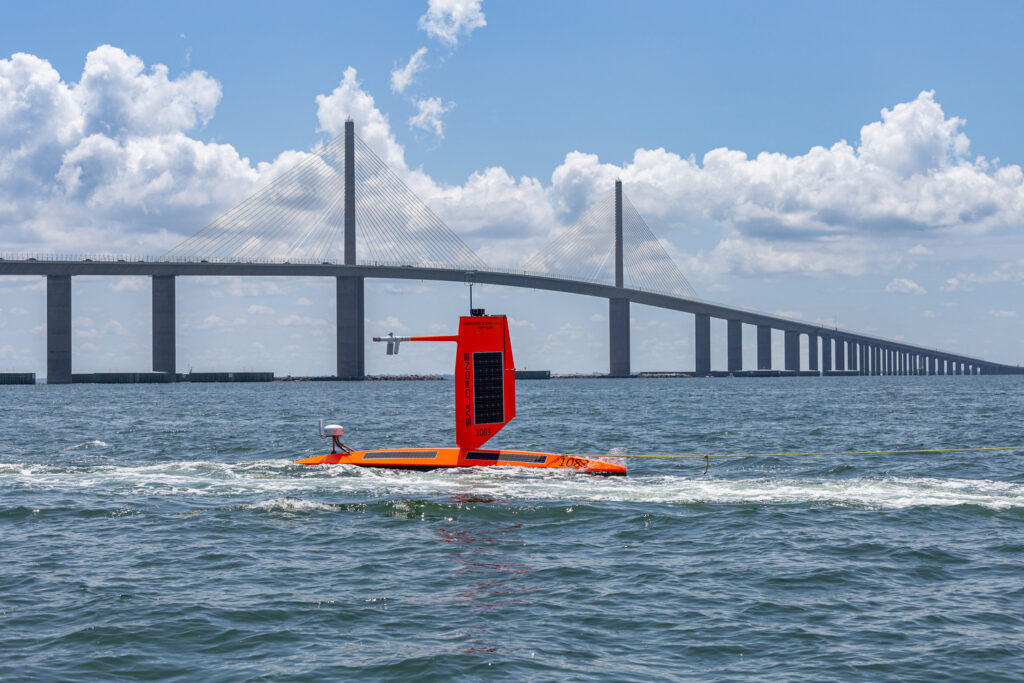A floating ocean drone deployed from the Port of St. Petersburg sailed through Hurricane Debby’s eye hours before the storm came ashore in north Florida.
Saildrone deployed the uncrewed surface vessel (USV) just days before as part of an ongoing partnership with the National Oceanic and Atmospheric Administration (NOAA). The overarching goal is to increase the marine science community’s understanding of how dangerous storms form, track and intensify.
The USV encountered gusts of over 70 mph and wave heights reaching more than 16 feet. Saildrone Explorers can withstand winds topping 110 mph and swells exceeding 50 feet.
Saildrone video recorded from inside Hurricane Debby.
This marks the fourth year Saildrone and NOAA have partnered to study hurricanes. However, the 2024 mission that began Monday features new technology to measure the amount of carbon dioxide (CO2) the ocean absorbs and releases into the atmosphere.
“It’s not known how hurricanes affect the exchange of CO2 between the ocean and the atmosphere and how that impacts the global carbon budget,” said Greg Foltz, a NOAA oceanographer and one of the mission’s principal investigators, in a prepared statement.
“If we can get one of these two USVs into a major storm, it would give us some of the first direct measurements of air-sea CO2 exchange inside a hurricane.”
The odds of success are favorable. NOAA predicts an 85% chance of an above-normal hurricane season due to near-record ocean heat, weather patterns off the Pacific coast, reduced Atlantic trade winds and below-average wind shear – ingredients that will likely keep meteorologists busy through November.
Saildrone, which operates an outpost in St. Petersburg’s Innovation District at the Maritime Defense and Technology Hub, got an early start on the 2024 mission. A USV deployed from St. Thomas intercepted Hurricane Beryl in early July as it quickly became a Category 5 storm with winds reaching 165 mph.

A Saildrone Explorer deploys from the Port of St. Petersburg.
Saildrone Explorers are 23 feet long and carry a sensor array to measure air, surface and water temperature and humidity, wind speed and direction, salinity, wave height and duration. In addition, two USVs now carry instruments that quantify carbon exchange.
NOAA scientists spent nearly two decades developing the sensors for Saildrone. Accurately understanding the sources of CO2 and where emissions end up is critical to forming climate policies and projections.
“The ocean plays a critical role in carbon storage, as it holds about 50 times more carbon than the atmosphere,” NOAA wrote in 2019. “Two-way carbon exchange can occur quickly between the ocean’s surface waters and the atmosphere, but carbon may be stored for centuries at the deepest depths.”
The recently released USVs float autonomously along predetermined routes according to weather conditions and mission objectives. Scientists at NOAA’s Atlantic Oceanographic & Meteorological Laboratory and Pacific Marine Environmental Laboratory work closely with Saildrone Mission Control to guide the vessels into oncoming hurricanes.
Researchers coordinate data collection between Saildrones, NOAA P3 Hurricane Hunter aircraft and submersible gliders. Integrating those assets provides a holistic picture of conditions from 30,000 feet above sea level to 3,000 feet below the surface.
Saildrone USVs utilize wind and solar energy, which allows the fleet to remain at sea without refueling until the mission concludes in October. Matt Womble, senior director of Ocean Data Programs, previously noted that Saildrone’s unique platform allows it to enter “some of the most inhospitable, worst environments” imaginable.
“And that has big implications for people in the path of storms and how they make decisions about evacuating and protecting their lives and property in advance …” he added.

The local uncrewed surface vessel will hunt hurricanes through October.
The post Saildrone slogs through Debby, studies carbon exchange appeared first on St Pete Catalyst.
